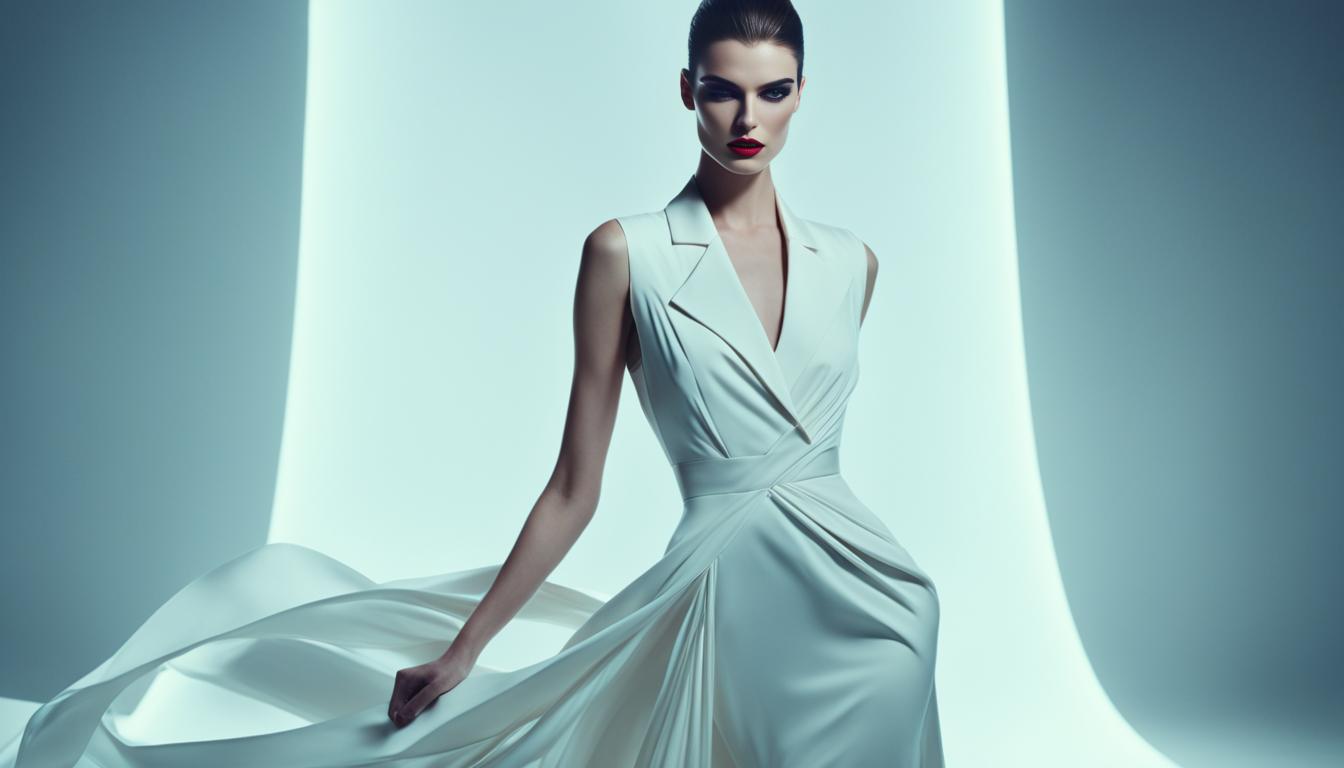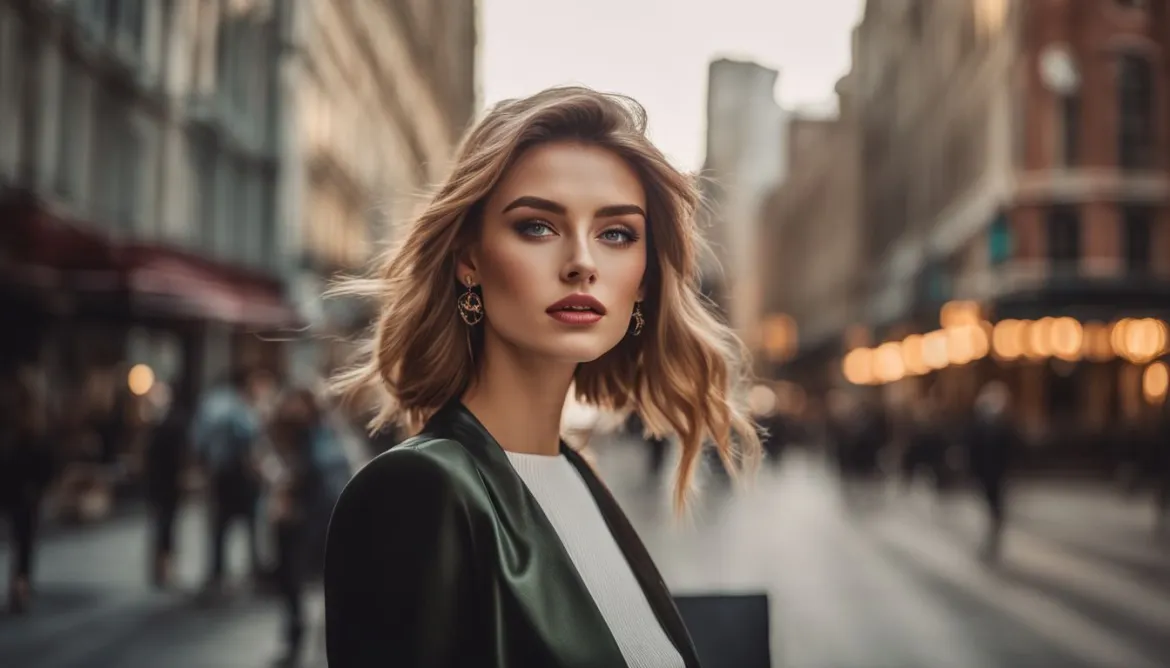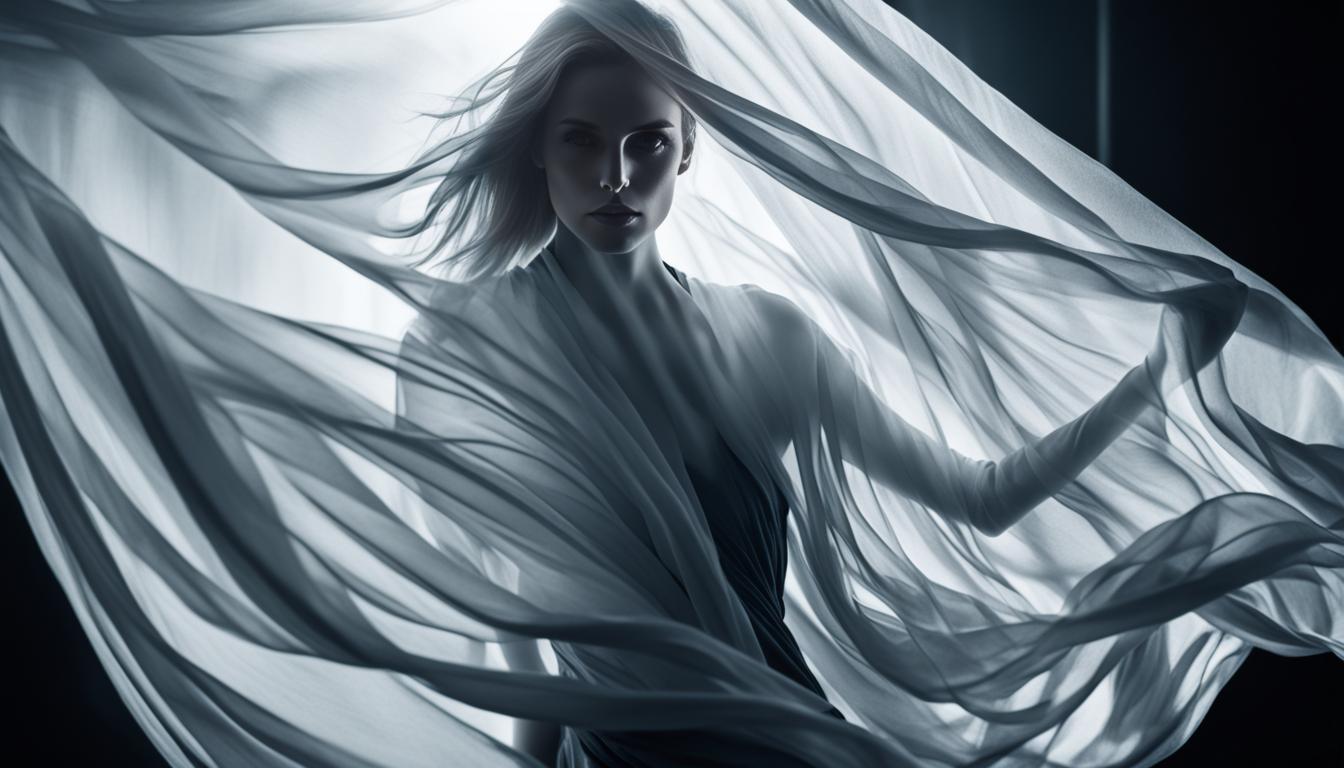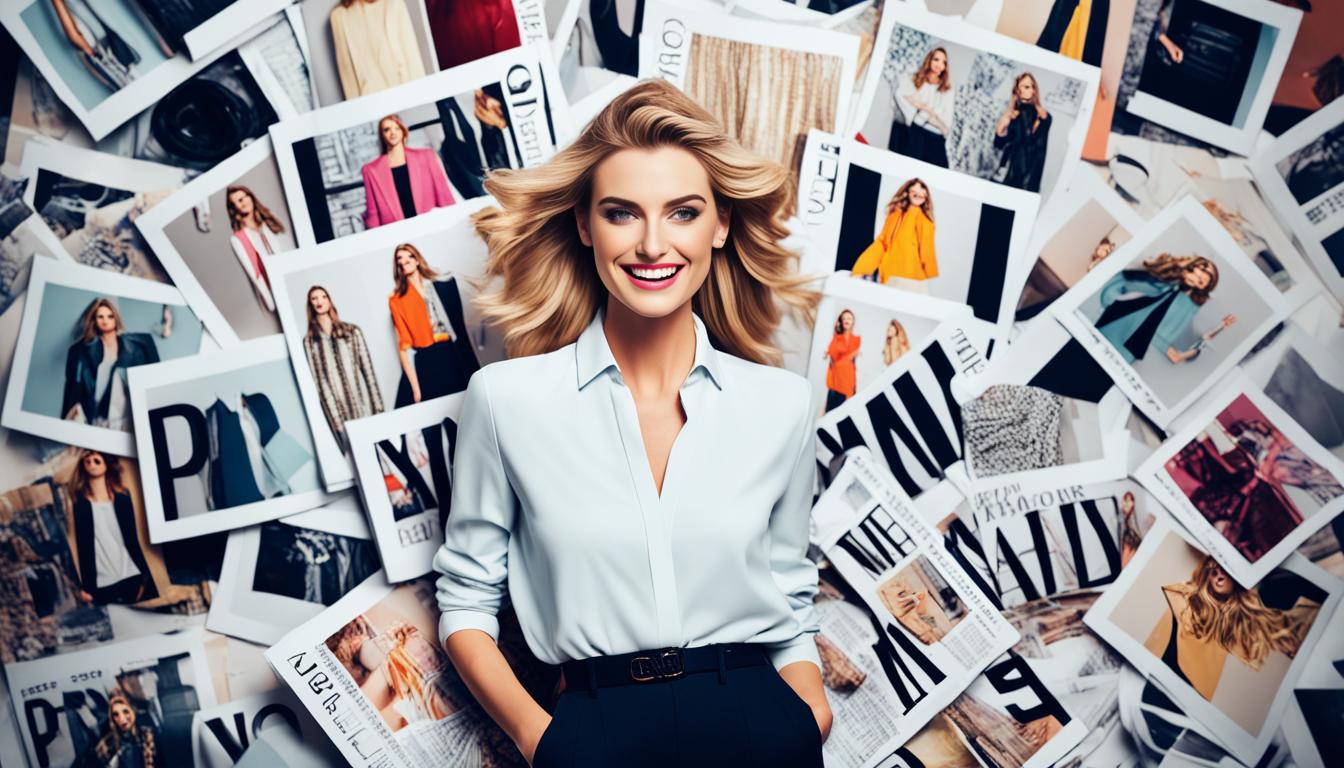Fashion photography is a captivating genre that allows us to showcase clothing, accessories, and beauty in a visually compelling way. It is a crucial element in the fashion industry, enabling us to promote brands and create a desire for their products. To excel in fashion photography, we need to grasp the basics, including understanding the genre, mastering essential techniques, and embracing various styles.
Understanding the genre of fashion photography is essential as it involves capturing garments, accessories, and beauty products in their best light. By studying fashion photography, we can appreciate its unique concepts, composition techniques, lighting strategies, and posing styles.
The basics of fashion photography encompass a wide range of techniques and concepts. From composition techniques that enhance the visual impact of an image to lighting techniques that create different moods and styles, we need to master these fundamentals to produce compelling fashion photographs.
Furthermore, a solid understanding of fashion photography styles is crucial. Fashion photography encompasses a variety of styles, ranging from editorial and high fashion to lifestyle and street-style photography. Each style requires a unique approach and creative vision, so we must familiarize ourselves with the nuances of each genre.
Key Takeaways:
- To succeed in fashion photography, it is crucial to understand the genre’s unique concepts and styles.
- Mastering composition, lighting, and posing techniques are essential for creating visually compelling fashion photographs.
- There are various styles within fashion photography, each requiring a distinct approach and creative vision.
Understanding the Fundamentals of Fashion Photography
To excel in fashion photography, it is essential to have a strong grasp of the fundamentals. This section will explore the key elements that contribute to creating stunning fashion photographs.
The Power of Composition and Framing
Composition and framing form the backbone of captivating fashion imagery. Careful consideration of these elements can elevate your photographs from ordinary to extraordinary. By arranging the various elements within the frame, you can guide the viewer’s eye and create a harmonious balance within the image. Experiment with different compositional techniques such as the rule of thirds, leading lines, and negative space to add visual interest and keep your audience engaged.
Exploring Color Theory and Color Grading
Color has a profound impact on the mood and tone of fashion photography. Understanding color theory can help you make deliberate choices to evoke specific emotions in your audience. Experiment with complementary, analogous, or monochromatic color schemes to create harmonious or contrasting palettes. Additionally, color grading during post-processing can enhance the overall aesthetic and narrative of your images. Use color grading tools to fine-tune colors, add depth, and create a cohesive visual story.
Capturing Mood and Emotion in Fashion Photography
One of the crucial aspects of fashion photography is the ability to convey mood and emotion. Through lighting, posing, styling, and post-processing, you can create images that evoke a specific atmosphere and resonate with your viewers. Understanding the desired mood and story you wish to tell is essential in directing your creative choices. Experiment with different lighting setups, poses, and editing techniques to capture the desired emotions, whether it’s a sense of drama, serenity, or excitement.
Key Takeaways
- Composition and framing play a vital role in creating visually appealing fashion photographs.
- Color theory and color grading help set the mood and tone of your images.
- Mastering lighting, posing, styling, and post-processing techniques is essential to capture and convey the desired mood and emotion.
Now that we’ve explored the fundamentals of fashion photography, it’s time to delve deeper into the specific aspects that contribute to creating compelling images. In the upcoming sections, we will discuss choosing the right camera and equipment, mastering lighting techniques, creating concepts and storyboards, directing models, and more.
Choosing the Right Camera and Equipment for Fashion Photography
When it comes to fashion photography, selecting the right camera and equipment is of utmost importance. The quality of your equipment can greatly impact the outcome of your images. To capture the essence and beauty of fashion, we recommend considering the following:
Full-Frame DSLR or Mirrorless Cameras
For fashion photography, full-frame DSLR or mirrorless cameras are popular choices due to their versatility and excellent image quality. These cameras offer larger sensors, which result in sharper and more detailed photographs. They also perform exceptionally well in low-light conditions, allowing you to capture stunning images even during nighttime shoots. Some reputable brands to consider include Nikon, Canon, Sony, and Fujifilm.
Prime Lenses for Fashion Portraits
When it comes to fashion portraits, prime lenses are highly recommended. These fixed focal length lenses offer superior sharpness and image quality compared to zoom lenses. Popular choices include the 50mm and 85mm lenses, which provide a flattering perspective, excellent depth of field, and stunning bokeh. These lenses allow you to capture the intricate details and textures of your subject while ensuring a professional and polished look.
Sturdy Tripod for Stability
A sturdy tripod is an essential piece of equipment for fashion photography, especially when shooting in controlled environments such as studios. Using a tripod ensures stability and eliminates any camera shake, resulting in sharper images. It also allows you to achieve precise composition and framing. Look for a tripod that offers height adjustability, durability, and compatibility with your chosen camera.
Reflector for Bouncing Light
A reflector is an indispensable tool that helps manipulate light during fashion shoots. It allows you to direct and soften light, highlight certain aspects of your subject, and create a flattering and well-balanced illumination. Reflectors come in various shapes, sizes, and colors, such as silver, gold, white, and translucent. Experimenting with different reflector types can add depth and dimension to your fashion photographs.
Remote Shutter Release for Camera Stability
When shooting fashion photography, even the slightest camera movement can impact image sharpness. A remote shutter release allows you to trigger the camera without physically touching it, reducing the risk of camera shake. This is particularly useful when working with longer exposures, such as in low-light situations. A wireless or cable remote shutter release ensures that your images remain crisp and blur-free.
“Choosing the right camera and equipment is essential in fashion photography. It allows you to capture the intricate details, textures, and beauty of fashion while maintaining professional image quality.”
With the right camera and equipment at your disposal, you can take your fashion photography to new heights. The combination of a full-frame DSLR or mirrorless camera, prime lenses, a sturdy tripod, reflector, and remote shutter release empowers you to capture stunning fashion images with precision and artistic flair. By investing in high-quality equipment, you can elevate your fashion photography and stand out in this competitive industry.
| Camera and Equipment | Advantages |
|---|---|
| Full-Frame DSLR or Mirrorless Cameras | – Versatility and excellent image quality – Superior low-light performance – Wide range of lens options |
| Prime Lenses | – Superior sharpness and image quality – Flattering perspective and depth of field – Stunning bokeh effects |
| Sturdy Tripod | – Stability and elimination of camera shake – Precise composition and framing – Suitable for controlled environments |
| Reflector | – Manipulation of light – Softening and directing light – Creation of flattering illumination |
| Remote Shutter Release | – Minimization of camera shake – Ideal for longer exposures – Convenience and ease of use |
Mastering Lighting Techniques for Fashion Photography
Lighting is a critical aspect of fashion photography. It can greatly influence the mood, style, and impact of an image. As fashion photographers, we strive to master various lighting techniques to create stunning visuals that highlight our subjects and evoke the desired emotions. Whether we are working with natural light, studio lighting, or artificial lighting, understanding how to manipulate light is essential to our craft.
Natural Light:
Working with natural light allows us to capture the beauty of our subjects in the most organic and authentic way. The soft, diffused light of dawn or dusk, known as the golden hour, can create a warm and ethereal atmosphere. On the other hand, the strong and directional light during midday can be used to create bold and dramatic images. Understanding the quality and direction of natural light is key to utilizing it effectively in fashion photography.
Studio Lighting:
Studio lighting provides us with control and precision over the lighting setup. By using different types of lighting equipment, such as strobes, softboxes, and reflectors, we can shape the light to achieve different effects and moods. From high-key lighting, which produces bright and evenly lit images, to low-key lighting, which creates strong contrasts and shadows, the possibilities with studio lighting are endless.
Artificial Lighting:
Artificial lighting gives us the flexibility to create our desired lighting conditions regardless of the time of day or location. Continuous lighting, such as LED panels, provides a constant light source, allowing us to preview and adjust the lighting setup in real-time. On the other hand, flash photography offers a burst of powerful light, freezing motion and adding a sense of energy to the images.
Now, let’s explore some popular lighting techniques that can elevate our fashion photography:
| Lighting Technique | Description |
|---|---|
| Rembrandt Lighting | A technique that creates a triangular patch of light on one side of the face, with a small triangle of light on the opposite cheek |
| Butterfly Lighting | A technique where the main light is positioned directly above and slightly in front of the model, creating a small shadow under the nose |
| Loop Lighting | A technique that creates a small loop-shaped shadow on one side of the model’s face |
| Split Lighting | A technique where the main light illuminates only one side of the face, creating a dramatic split between light and shadow |
| High Key Lighting | A technique that produces bright, evenly lit images, often used in fashion shoots that require a clean and polished aesthetic |
| Low Key Lighting | A technique that creates strong contrasts and shadows, often used to evoke mystery and drama in fashion photography |
| Rim Lighting | A technique where the light is positioned behind the model, creating a glowing outline around their silhouette |
| Backlighting | A technique where the light is positioned behind the model, creating a soft and ethereal effect, often used to emphasize the model’s form |
By mastering these lighting techniques and understanding how light interacts with our subjects, we can create captivating and visually striking fashion photographs that leave a lasting impression.

Creating a Concept and Storyboard for Fashion Photography
When it comes to fashion photography, creating a solid concept and storyboard is essential. It allows us to plan and visualize the entire shoot, ensuring that all the elements come together cohesively and effectively convey our desired message. Let’s explore the importance of establishing a concept and the process of creating a storyboard.
Establishing a Concept
A concept in fashion photography is the overarching theme or idea that drives the shoot. It sets the tone, mood, and style of the images, giving them a cohesive and unified feel. To establish a concept, we need to consider various factors such as the target audience, the purpose of the shoot (e.g., editorial, commercial), and the desired emotion or message we want to convey.
For example, if our concept is centered around portraying a bohemian-inspired fashion line, we would choose locations, props, and wardrobe that align with this theme. By creating a clear concept, we can ensure that every aspect of the shoot contributes to the overall vision.
Creating a Storyboard
A storyboard is a visual representation of our concept, mapping out the different shots and poses that will be captured during the shoot. It serves as a roadmap, guiding us through the entire process and ensuring that we don’t miss any important shots.
To create a storyboard, we can sketch out rough illustrations or use reference images to visualize our ideas. We can organize the storyboard into a sequential order, outlining the poses, camera angles, lighting setups, and any specific details we want to capture.
Having a well-defined storyboard not only helps us stay organized during the shoot but also allows us to effectively communicate our vision to the entire creative team, including the models, stylists, makeup artists, and lighting technicians.
Planning and Visualizing a Shoot
Creating a concept and a storyboard is an integral part of the planning process. It enables us to visualize how different elements will come together in the final images. By pre-visualizing the shoot, we can make more informed decisions about locations, lighting setups, poses, and styling choices.
Whether it’s a simple outdoor shoot or an elaborate studio production, having a clear concept and a detailed storyboard helps us save time and create a cohesive series of images that align with our vision.
Remember, the key to successful fashion photography lies in the careful planning and execution of a well-thought-out concept and storyboard. By establishing a concept that resonates with our target audience and creating a detailed storyboard, we can ensure that our images tell a story and make a lasting impact.
Directing Models and Posing Techniques in Fashion Photography
Directing models and utilizing posing techniques are essential skills for fashion photographers. As photographers, it is our responsibility to guide and inspire models to capture the desired poses and expressions. Clear communication, effective guidance, and constructive feedback are necessary to achieve outstanding results.
In order to create the best possible photographs, it is important to build a rapport with models, creating a comfortable and relaxed environment. By establishing a positive connection, we can help models feel at ease and bring out their natural beauty and personality, resulting in more authentic and captivating images.
Understanding the desired mood and style of the shoot is crucial for directing models effectively. By aligning our vision with the concept and theme of the fashion editorial or campaign, we can provide models with specific instructions that accentuate the overall aesthetic.
Posing Techniques
Posing techniques play a significant role in fashion photography. By mastering various poses, we can create visually dynamic and engaging compositions that showcase the garments and accessories in the best light.
Some essential posing techniques include:
- Power posing: Emphasizing strong and confident poses can convey a sense of empowerment and allure.
- Fluid movements: Encouraging models to move gracefully and fluidly can create a sense of dynamism and energy in the photographs.
- Casual and natural poses: Capturing candid moments and relaxed postures can add authenticity and a touch of spontaneity to the images.
Providing Guidance and Feedback
To direct models effectively, it is important to provide clear guidance and constructive feedback throughout the shoot. By articulating our vision and desired outcomes, we can help models understand and embody the concept accurately. Regularly offering feedback and encouragement can also boost their confidence and motivation, resulting in better performance and collaboration.
“Posing is not just about creating aesthetically pleasing shapes, but also about evoking emotions and telling a story through body language.”
A Comfortable and Relaxed Environment
Creating a comfortable and relaxed environment is essential for the success of a fashion shoot. By fostering a positive and supportive atmosphere, models will feel more at ease and be more responsive to our direction. This can contribute to capturing genuine emotions and expressions, resulting in more impactful and memorable photographs.
To summarize, directing models and utilizing posing techniques are crucial aspects of fashion photography. By establishing clear communication, providing guidance and feedback, and creating a comfortable environment, we can capture stunning images that resonate with viewers and effectively convey the essence of the fashion brand or editorial.
Styling and Wardrobe Selection in Fashion Photography
When it comes to fashion photography, styling and wardrobe selection are fundamental aspects that contribute to the overall aesthetic and impact of the images. As fashion photographers, our role is not only to capture beautiful photographs but also to curate a visual story that speaks to the audience.
We work closely with experienced stylists to ensure that the clothing, accessories, and props chosen align perfectly with the concept and vision of the shoot. Together, we consider various factors when selecting wardrobe pieces, such as the model’s body type, skin tone, and personal style. Our goal is to flatter the model’s figure while showcasing the clothing in the most captivating way.
Texture, pattern, and movement are vital elements that we take into account during the wardrobe selection process. We choose fabrics and materials that add depth and visual interest to the photographs. Whether it’s a flowing dress, a structured suit, or a textured accessory, each piece contributes to the overall composition and storytelling of the image.
It’s essential to create harmony between the model, the clothing, and the overall concept. By considering the texture, pattern, and movement of the wardrobe, we can enhance the visual impact and create a cohesive visual narrative.

Ultimately, styling and wardrobe selection form an integral part of the fashion photographer’s creative process. By meticulously curating the wardrobe and paying attention to detail, we create images that not only showcase the latest trends but inspire and evoke emotion.
Using Props and Accessories in Fashion Photography
When it comes to fashion photography, props and accessories are powerful tools that can elevate the visual impact of your images. These elements not only complement the clothing being showcased but also add interest and depth to your photographs.
Think of hats, scarves, jewelry, bags, and even furniture or architectural elements as the supporting actors in your fashion story. They help create a cohesive narrative and enhance the overall aesthetic. Whether you’re aiming for a glamorous, edgy, or bohemian vibe, the right props and accessories can make a world of difference.
However, it’s important to tread carefully when using props and accessories. They should enhance the composition and contribute to the overall narrative, without overpowering or distracting from the main subject – the model and the clothing. Consider how these elements interact with the model and the overall composition, ensuring a harmonious and visually pleasing result.
So, don’t be afraid to experiment and get creative with props and accessories in your fashion photography. They have the power to transform your images, adding that extra touch of interest and depth that will captivate viewers and leave a lasting impression.
FAQ
What is fashion photography?
Fashion photography is a genre that showcases clothing, accessories, and beauty in a visually appealing way. It plays a vital role in the fashion industry, promoting brands and creating a desire for their products.
What are the basics of fashion photography?
The basics of fashion photography include understanding composition and framing, color theory and color grading, as well as capturing the right mood and emotion through lighting, posing, styling, and post-processing techniques.
How do I choose the right camera and equipment for fashion photography?
For fashion photography, it is recommended to use full-frame DSLR or mirrorless cameras. Popular lens choices include prime lenses such as 50mm or 85mm. Other essential equipment includes a sturdy tripod, reflector, and remote shutter release.
What lighting techniques are used in fashion photography?
Fashion photographers use various lighting techniques, including natural light, studio lighting, and artificial lighting. Different lighting setups such as Rembrandt lighting, butterfly lighting, loop lighting, split lighting, high key lighting, low key lighting, rim lighting, and backlighting are utilized to achieve different moods and styles.
How do I create a concept and storyboard for a fashion photography shoot?
Creating a concept and storyboard involves planning and visualizing the shoot. The concept is the overall theme or idea of the shoot, while the storyboard maps out the different shots and poses to be captured.
How do I direct models and utilize posing techniques in fashion photography?
Effective communication, guidance, and feedback are crucial when directing models. Building rapport and creating a comfortable environment helps bring out their natural beauty and personality. Understanding the desired mood and style of the shoot and adjusting poses accordingly is also important.
What is the role of styling and wardrobe selection in fashion photography?
Styling and wardrobe selection play a crucial role in fashion photography. The fashion photographer works closely with stylists to ensure that the clothing, accessories, and props align with the concept and vision of the shoot. Factors such as the model’s body type, skin tone, and personal style are considered when selecting wardrobe pieces.
How can props and accessories enhance fashion photography?
Props and accessories can add interest and depth to fashion photographs. They can enhance the visual impact, complement the clothing, and help tell a story. Hats, scarves, jewelry, bags, and even furniture or architectural elements can be used as props, as long as they enhance the overall aesthetic and do not overpower or distract.
How Can Sustainability and Ethics Impact the Genre of Fashion Photography?
Sustainability in fashion photography has the power to reshape the industry. Embracing ethical practices and environmentally friendly techniques can lead to more responsible production and consumption. By promoting sustainable values through visual storytelling, fashion photography can influence the entire supply chain and inspire positive change within the genre.




